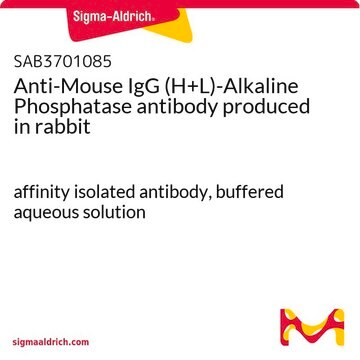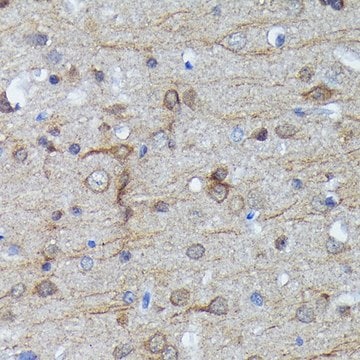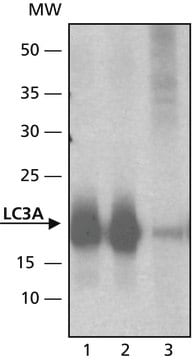Kluczowe dokumenty
SAB4200361
Anti-MAP1LC3B Antibody
mouse monoclonal, LC3B-6
Synonim(y):
Monoclonal Anti-ATG8F, Monoclonal Anti-LC3, Monoclonal Anti-MAP1A/1BLC3, Monoclonal Anti-MAP1LC3B, Monoclonal Anti-microtubule-associated protein 1 light chain 3 beta
Wybierz wielkość
2190,00 zł
Wybierz wielkość
About This Item
2190,00 zł
Polecane produkty
Nazwa produktu
Anti-LC3B antibody, Mouse monoclonal, clone LC3B-6, purified from hybridoma cell culture
pochodzenie biologiczne
mouse
Poziom jakości
białko sprzężone
unconjugated
forma przeciwciała
purified immunoglobulin
rodzaj przeciwciała
primary antibodies
klon
LC3B-6, monoclonal
Formularz
buffered aqueous solution
masa cząsteczkowa
antigen ~18/16 kDa
reaktywność gatunkowa
human
stężenie
~1.0 mg/mL
metody
immunoprecipitation (IP): 10-20 μg using lysates of human U-87 cells.
western blot: 1-2 μg/mL using whole extracts of HEK-293T cells over-expressing human LC3B.
izotyp
IgG2b
numer dostępu UniProt
Warunki transportu
dry ice
temp. przechowywania
−20°C
docelowa modyfikacja potranslacyjna
unmodified
informacje o genach
human ... MAP1LC3B(81631)
Opis ogólny
Immunogen
Zastosowanie
Immunofluorescence (1 paper)
Działania biochem./fizjol.
Postać fizyczna
Oświadczenie o zrzeczeniu się odpowiedzialności
Nie możesz znaleźć właściwego produktu?
Wypróbuj nasz Narzędzie selektora produktów.
Kod klasy składowania
10 - Combustible liquids
Temperatura zapłonu (°F)
Not applicable
Temperatura zapłonu (°C)
Not applicable
Wybierz jedną z najnowszych wersji:
Certyfikaty analizy (CoA)
Nie widzisz odpowiedniej wersji?
Jeśli potrzebujesz konkretnej wersji, możesz wyszukać konkretny certyfikat według numeru partii lub serii.
Masz już ten produkt?
Dokumenty związane z niedawno zakupionymi produktami zostały zamieszczone w Bibliotece dokumentów.
Klienci oglądali również te produkty
Active Filters
Nasz zespół naukowców ma doświadczenie we wszystkich obszarach badań, w tym w naukach przyrodniczych, materiałoznawstwie, syntezie chemicznej, chromatografii, analityce i wielu innych dziedzinach.
Skontaktuj się z zespołem ds. pomocy technicznej










